Physical Address
304 North Cardinal St.
Dorchester Center, MA 02124
The initial formation of the digestive system by the lateral folding of the endodermal germ layer into a tube is described in Chapter 6 . From its beginnings as a simple tubular gut, development of the digestive system proceeds on several levels, including molecular patterning, elongation and morphogenesis of the digestive tube itself, inductions and tissue interactions leading to the formation of the digestive glands, and the biochemical maturation of the secretory and absorptive epithelia associated with the digestive tract. Clinical Correlations 15.1 to 15.3 discuss malformations associated with the digestive system.
Formation of the respiratory system begins with an unimposing ventral outpocketing of the foregut. Soon, however, this outpocketing embarks on a unique course of development while still following some of the basic patterns of epithelial–mesenchymal interactions characteristic of other gut-associated glands. Initially, the digestive and respiratory systems form in a common body cavity, but functional considerations later necessitate the subdivision of this primitive body cavity into thoracic and abdominal components. Clinical Correlation 15.4 presents malformations associated with the respiratory system, and Clinical Correlation 15.5 discusses malformations related to other body cavities.
Chapter 6 describes the formation of the primitive endodermal digestive tube, which is bounded at its cephalic end by the oropharyngeal membrane and at its caudal end by the cloacal plate (see Figure 6.25 ). Because of its intimate relationship with the yolk sac through the yolk stalk , the gut can be divided into a foregut , an open-bottomed midgut , and a hindgut .
Initial patterning of the gut endoderm begins during the period of late gastrulation while the sheet of newly formed endoderm begins to form a gut tube. After initial broad patterning into anterior and posterior domains by nodal and fibroblast growth factor-4 (FGF-4), respectively, the overall organization of the gut gradually takes shape. Much of the patterning and of early morphogenesis of the gut occurs in response to the actions of several sets of molecular signals. While development and early organogenesis proceed, the same signaling molecules are reused. Paradoxically, the same molecule may play opposite roles in the same area but at different times (i.e., it may first act as a stimulator and within hours or days it may function as an inhibitor).
Patterning of the broad foregut area occurs through the inhibition of Wnt signals ( Figure 15.1 ). The foregut domain is then marked by the expression of the transcription factors, Gata-4, 6, Sox -2, Hhex , and Foxa-2 . ∗
∗ Foxa and Gata are called pioneer transcription factors because they open closed regulatory regions of chromatin to other transcription factors, allowing gene expression to take place. In this manner, they impart competence of a group of cells to receive an inductive signal from another source.
In contrast, a mix of activity by Wnts, FGFs, and bone morphogenetic proteins (BMPs), along with retinoic acid, represses foregut identity and maintains the regional identity of the hindgut. This is marked by the expression of the transcription factor Cdx-2 throughout the broad hindgut and the later expression of Pdx-1 in the midgut while this region emerges as a separate entity. Cdx-2 acts upstream of a broad range of Hox activity ( Figure 15.2 ) that is expressed throughout the gut. The activity of specific signaling molecules is associated with important transition points along the gut. FGF-4 is strongly expressed near the foregut–midgut boundary (around the duodenal–jejunal junction), and FGF-10 is associated with the establishment of the cecum.
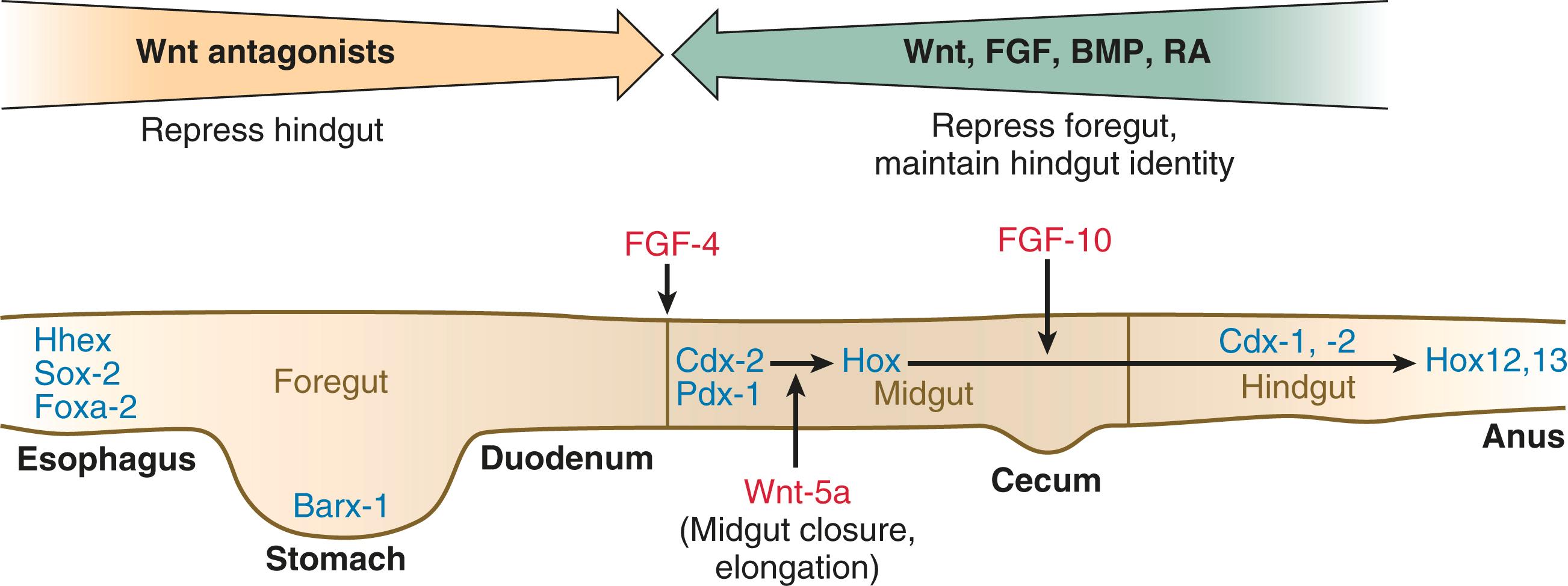
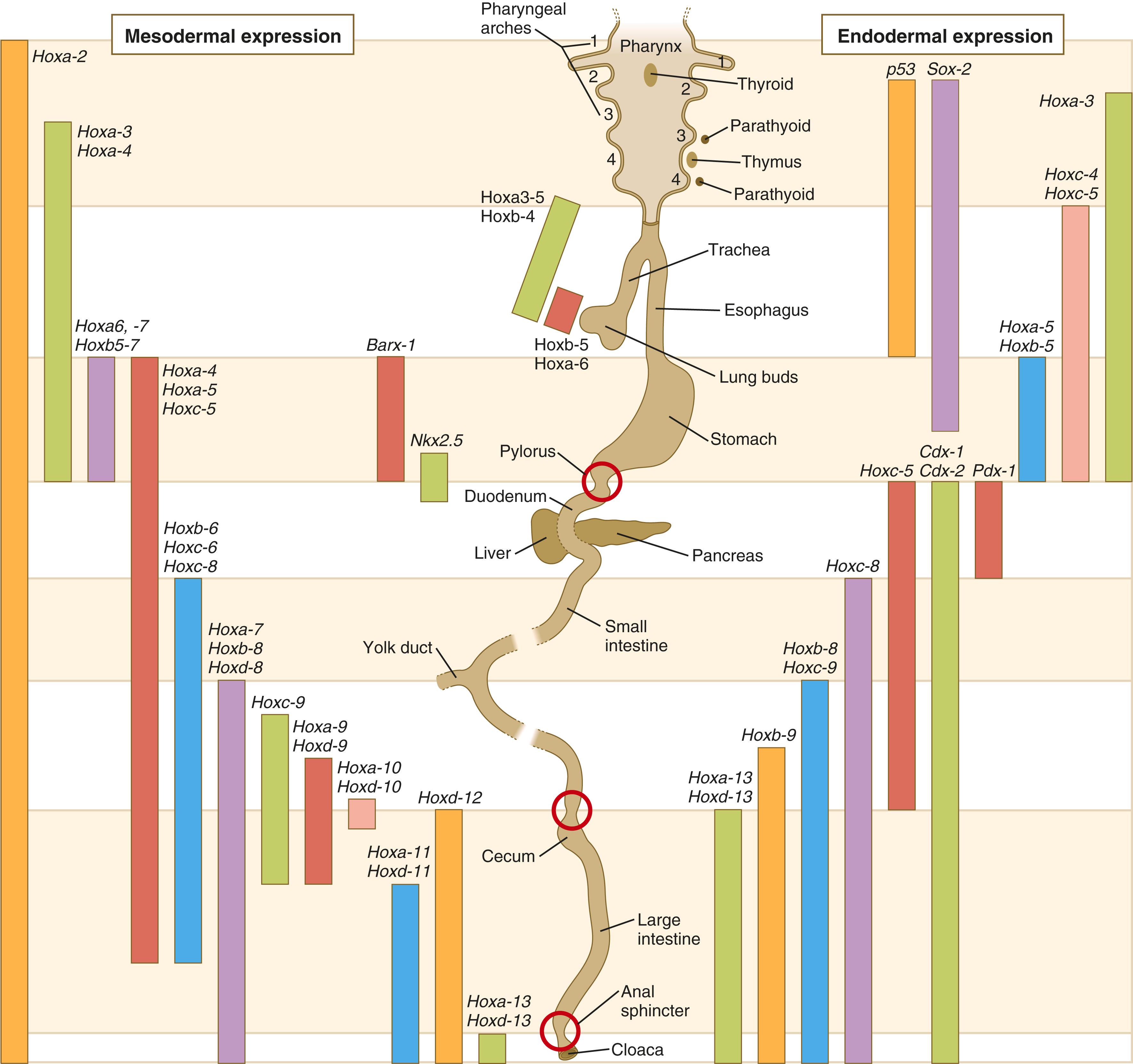
Largely through the action of Cdx-2, the orderly expression of homeobox-containing genes then takes over in the regional patterning of the digestive system (see Figure 15.2 ).
Mice bearing mutant copies of some of these genes develop several of the common structural malformations of the digestive tract that occur in humans. More dramatically, mice deficient in retinoic acid, a broad early patterning molecule, fail to form lungs and show severe defects of other posterior foregut derivatives, such as the stomach, duodenum, and liver. Development of the gut tube proper involves continuous elongation, herniation past the body wall, rotation and folding for efficient packing into the body cavity, and histogenesis and later functional maturation.
By the end of the first month, small endodermal diverticula, which represent primordia of the major digestive glands, can be identified ( Figure 15.3 ). (Development of the pharynx and its glandular derivatives are discussed in Chapter 14 .) The digestive glands and respiratory structures grow in complex branching patterns, resembling fractals, as the result of continuous epithelial–mesenchymal interactions. These interactions also occur in the developing digestive tube itself, with specific regional mesenchymal influences determining the character of the epithelium lining that part of the digestive tract.
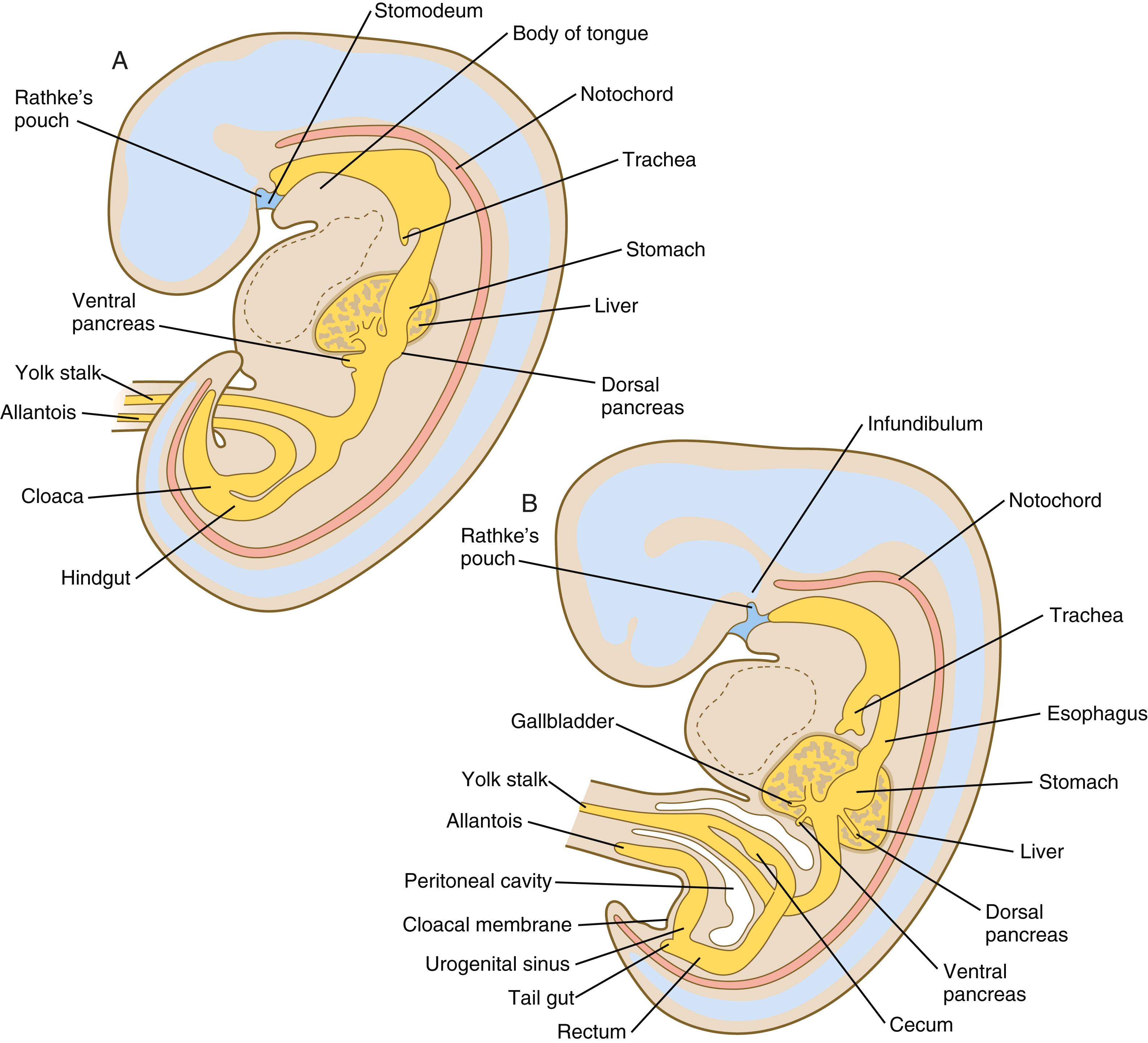
Each of the glandular derivatives of the digestive tract and the major regions along the gut are the result of a specific response by a small population of founder cells for each organ to a set of environmental inductive signals. At a first level, certain regions of the gut must be prepared to be either responsive or refractive to these signals. For example, after the overall foregut is specified by the suppression of Wnt and FGF signals, transforming growth factor-β (TGF-β) signaling restricts the specification of foregut endoderm to allow the prehepatic and prepancreatic endoderm to remain receptive to inductive signals. By the same token, other influences on the dorsal side of the foregut repress the ability of these cells to become liver or pancreas.
During neurulation, while the head bends sharply to create the foregut, the ventral foregut endoderm is closely opposed to two mesodermal masses: the cardiac mesoderm and the primordium of the septum transversum (see Figure 15.4 ). FGF, secreted by the cardiac mesoderm, and also retinoic acid induce the formation of the liver, lung bud, and thyroid (see Figure 15.4 ). The secreted FGF is present as a gradient. The highest level of FGF induces the lungs; the lowest, the pancreas; and an intermediate level induces the liver. BMP-4 and Wnt from the mesoderm of the septum transversum are also required for liver induction. On the other hand, BMP suppresses pancreatic development. Endodermal movements carry the preventral pancreas cells far enough from the cardiac mesoderm to expose them to a low level of FGF, thus allowing the ventral pancreas to develop. For the dorsal pancreas to develop, locally produced sonic hedgehog (shh) must be inactivated by activin and FGF emanating from the notochord. In addition, retinoic acid from the somitic mesoderm is needed for induction of the dorsal pancreas. Meanwhile, in the hindgut, the actions of Wnt and other signaling molecules repress the expression of genes, such as Hhex and Pdx1 , which are essential for formation of the liver and pancreas, respectively.
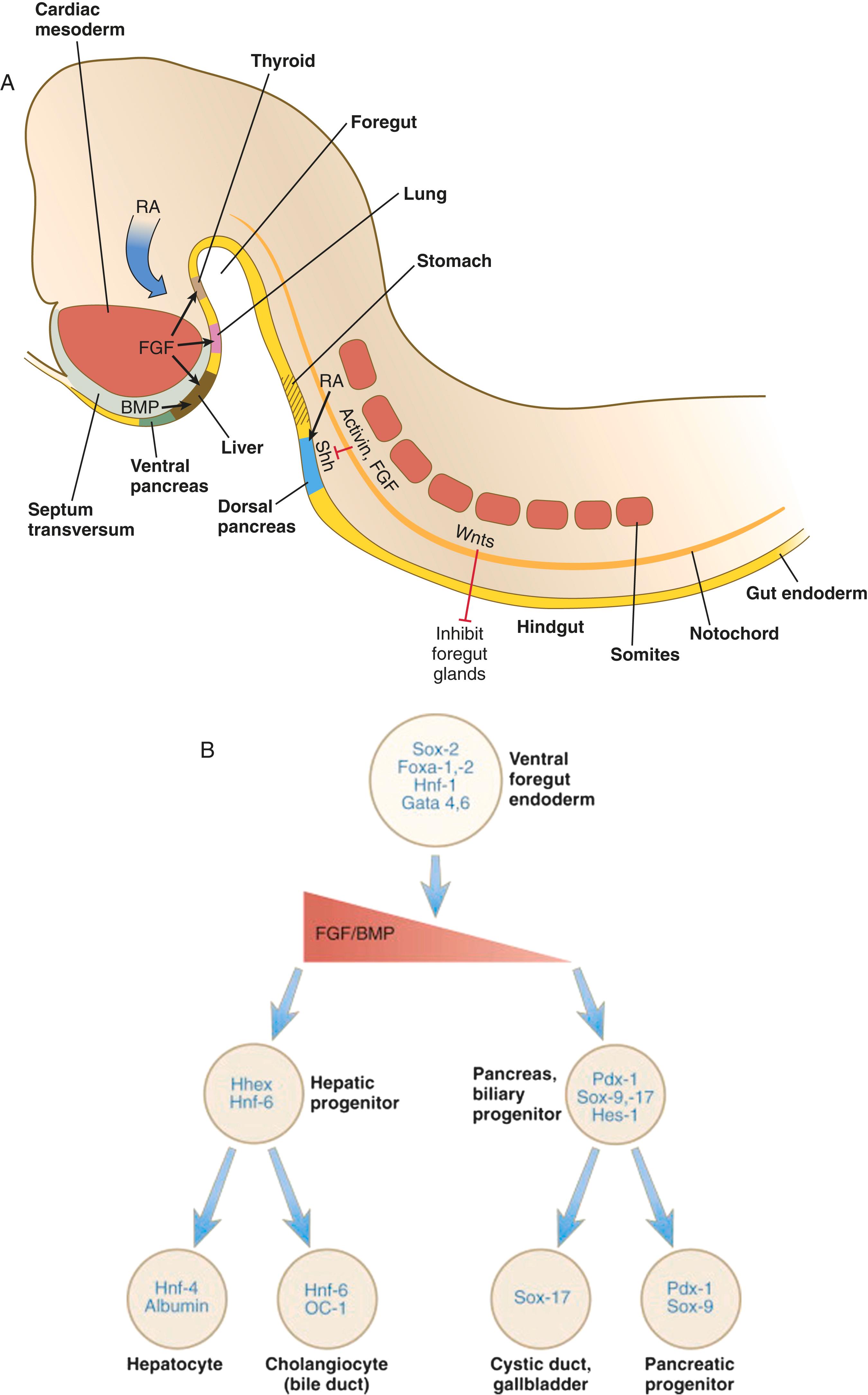
Induction of these organs is marked by the activation of transcription factors specific for the organ and stage of development of that organ. Some of these factors are schematically represented in Figure 15.4B .
During the third week of development, the foregut posterior to the pharynx consists of a single tube that contains cellular precursors of both the esophagus and the trachea. The dorsal portion of the tube, which will become esophagus , expresses Sox-2, whereas the ventral portion, which will become trachea, expresses Nkx-2.1 (see Figure 15.31 ). Just caudal to the most posterior pharyngeal pouches of a 4-week-old embryo, the pharynx is abruptly narrowed, and a small ventral outgrowth (lung bud) appears (see Figure 6.25 ). The region of foregut just caudal to the lung bud is the esophagus. This segment is initially very short, with the stomach seeming to reach almost to the pharynx. In the second month of development, during which the gut elongates considerably, the esophagus assumes nearly postnatal proportions in relation to the location of the stomach.
Although the esophagus grossly resembles a simple tube, it undergoes a series of striking differentiative changes at the tissue level. In its earliest stages, the endodermal lining epithelium of the esophagus is stratified columnar. By 8 weeks, the epithelium has partially occluded the lumen of the esophagus, and large vacuoles appear ( Figure 15.5 ). In succeeding weeks, the vacuoles coalesce, and the esophageal lumen recanalizes but with multilayered ciliated epithelium. During the fourth month, under the influence of p63 , the master regulator of stratified squamous epithelial development, working through the Notch signaling pathway, the columnar epithelium finally is replaced with the stratified squamous epithelium that characterizes the mature esophagus.
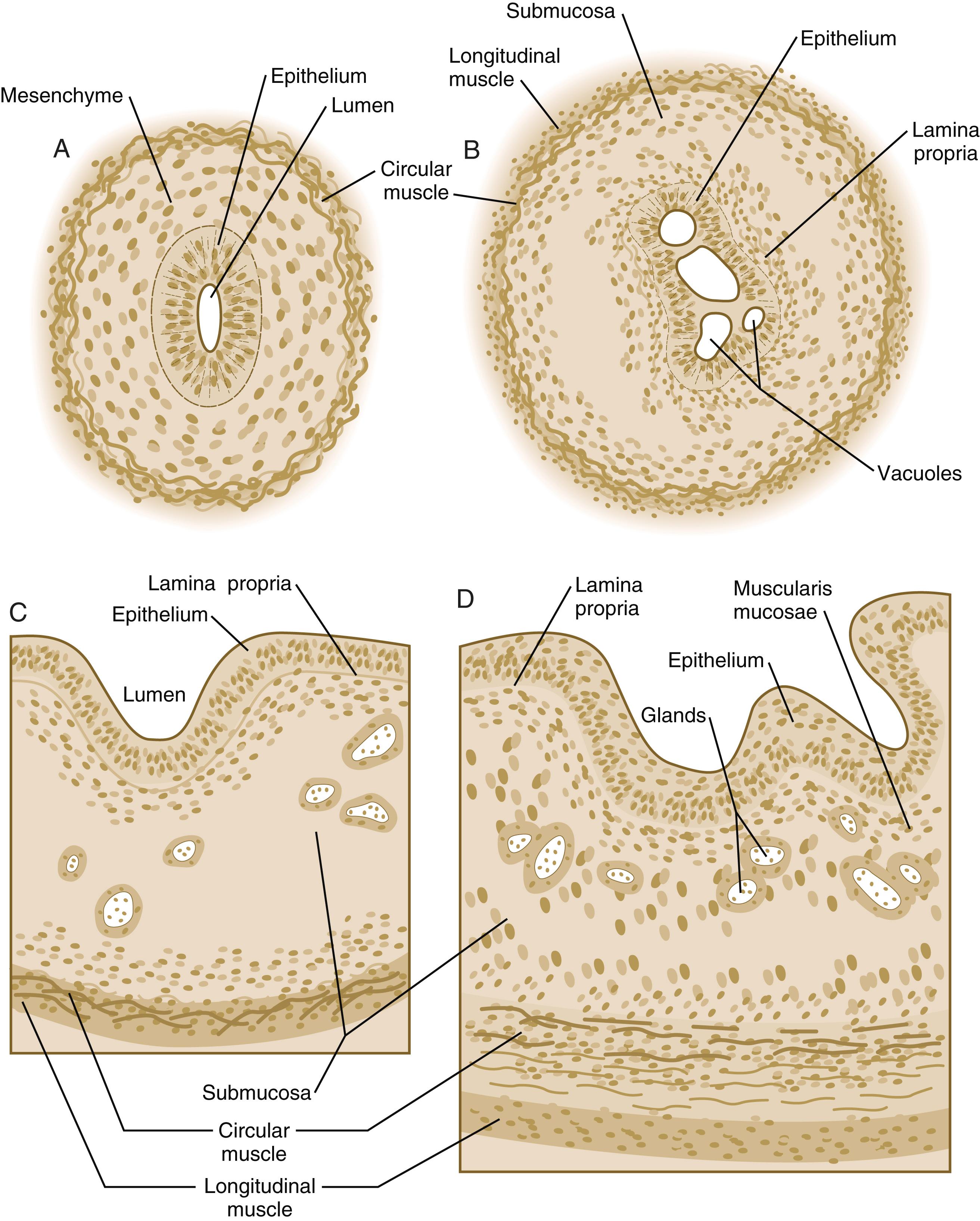
Deeper in the esophageal wall, layers of muscle also differentiate in response to inductive signals from the gut endoderm. Very early (5 weeks’ gestation), the primordium of the inner circular muscular layer of esophagus is recognizable, and by 8 weeks the outer longitudinal layer of muscle begins to take shape. Finally, the smooth muscle of the muscularis mucosae appears. The esophageal wall contains smooth and skeletal muscle. The smooth muscle cells differentiate from the local splanchnic mesoderm associated with the gut, and the skeletal musculature is derived from pharyngeal paraxial mesoderm. The skeletal muscle precursor cells, which express the Isl-1 marker of cardiopharyngeal mesoderm, first enter the esophagus near the pharynx and then migrate toward the stomach. They never reach the lower third of the esophagus. The esophageal musculature is innervated by enteric neurons derived from Schwann cells of the vagus nerve and pharyngeal neural crest.
The cross-sectional structure of the esophagus, similar to that of the rest of the gut, is organized into discrete layers. The innermost layer ( mucosa ) consists of the epithelium, derived from endoderm, and an underlying layer of connective tissue, the lamina propria , which overlies the muscularis mucosae (see Figure 15.5C and D ). A thick layer of loose connective tissue ( submucosa ) separates the mucosa from the outer layers of muscle (usually smooth muscle, with the exception of the upper esophagus). This radial organization is regulated by the epithelial expression of shh , acting through its receptor, patched , and BMP-4 . Shh inhibits the formation of smooth muscle in the submucosal layer of the esophagus. Farther from the source of the endodermal shh, smooth muscle can differentiate in the outer wall of the intestine. How the developing smooth muscle layer of the mucosa (muscularis mucosae) escapes this inhibitory influence is unclear. Intestinal mesenchyme can spontaneously differentiate into smooth muscle in the absence of an epithelium (which produces shh). Because in humans the muscularis mucosae differentiates considerably later than the outer muscular layers, it is possible that inhibitory levels of shh are reduced by that time.
Formation of the stomach within the foregut is first specified by the action of the transcription factors Hoxa-5 and Barx-1 , which inhibits the posteriorizing effects of Wnt signaling in the region of the future stomach. A second phase of specification follows, in which a descending posterior-to-anterior gradient of FGF-10 and a descending anterior-to-posterior gradient of Wnt, produced in the gastric mesoderm, begins the process of regional differentiation of the glandular character of the gastric epithelium. High levels of Wnt stimulate the development of the fundic (acid-producing) part of the stomach, whereas high levels of FGF-10 pattern the antral (glandular) region.
Very early in the formation of the digestive tract, the stomach is recognizable as a dilated region with a shape remarkably similar to that of the adult stomach (see Figure 15.3 ). The early stomach is suspended from the dorsal body wall by a portion of the dorsal mesentery called the dorsal mesogastrium . It is connected to the ventral body wall by a ventral mesentery that also encloses the developing liver ( Figure 15.6 ).
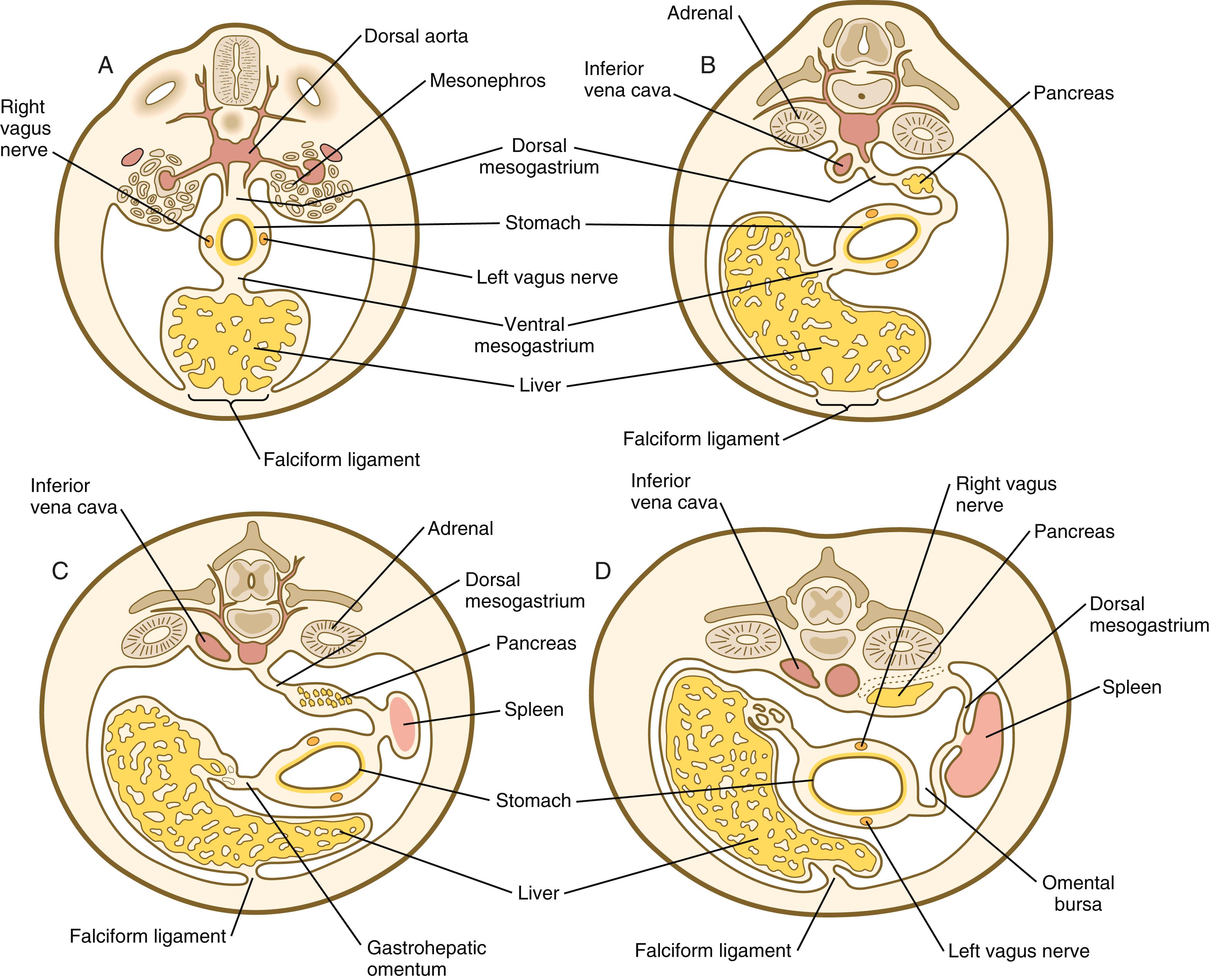
When the stomach first appears, its concave border faces ventrally, and its convex border faces dorsally. Two concomitant positional shifts bring the stomach to its adult configuration. The first is an apparent approximately 90-degree rotation about its craniocaudal axis so that its originally dorsal convex border faces left, and its ventral concave border faces right. Two different mechanisms have been proposed to explain this positional shift. One is that the stomach actually rotates about the craniocaudal axis. The other attributes the shift to differential growth of the wall of the stomach, namely expansion of the left wall and a corresponding shift in the dorsal mesogastrium through a breakdown of the right portion of the earlier mesogastrium. The other positional shift consists of a minor tipping of the caudal (pyloric) end of the stomach in a cranial direction so that the long axis of the stomach is positioned diagonally across the body ( Figure 15.7 ).
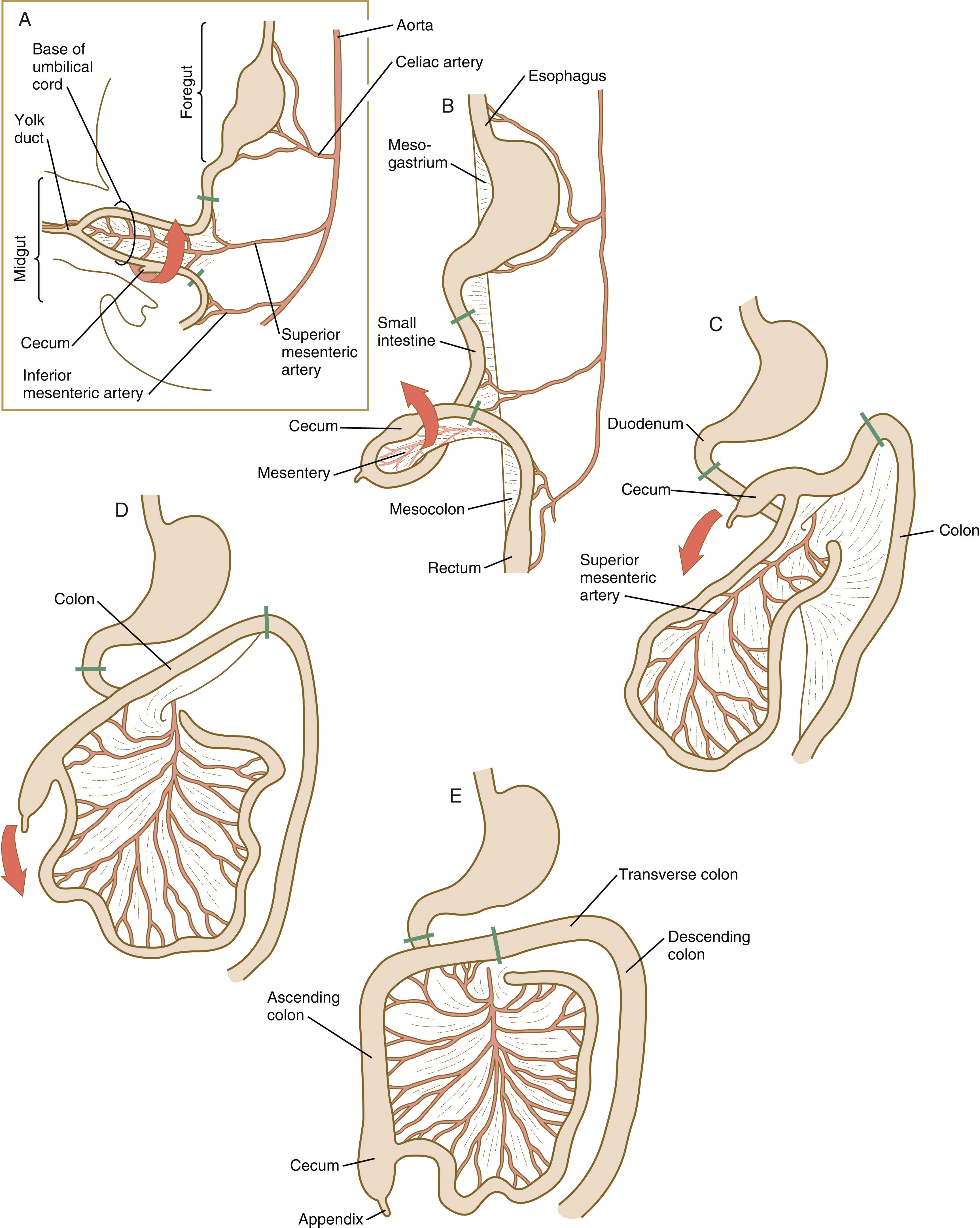
During rotation of the stomach, the dorsal mesogastrium is carried with it, thus leading to the formation of a pouchlike structure called the omental bursa ( bursa is a Latin word meaning “sac” or “pouch”). Both the spleen and the tail of the pancreas are embedded in the dorsal mesogastrium (see Figure 15.6 ). Another viewpoint suggests that the right pneumatoenteric recess, a projection from the pleural cavity into the dorsal mesogastrium, persists as the omental bursa.
While the stomach rotates, the dorsal mesogastrium and the omental bursa that it encloses enlarge dramatically. Soon, part of the dorsal mesogastrium, which becomes the greater omentum , overhangs the transverse colon and portions of the small intestines as a large, double flap of fatty tissue ( Figure 15.8 ). The two sides of the greater omentum ultimately fuse and obliterate the omental bursa within the greater omentum. The rapidly enlarging liver occupies an increasingly large portion of the ventral mesentery.
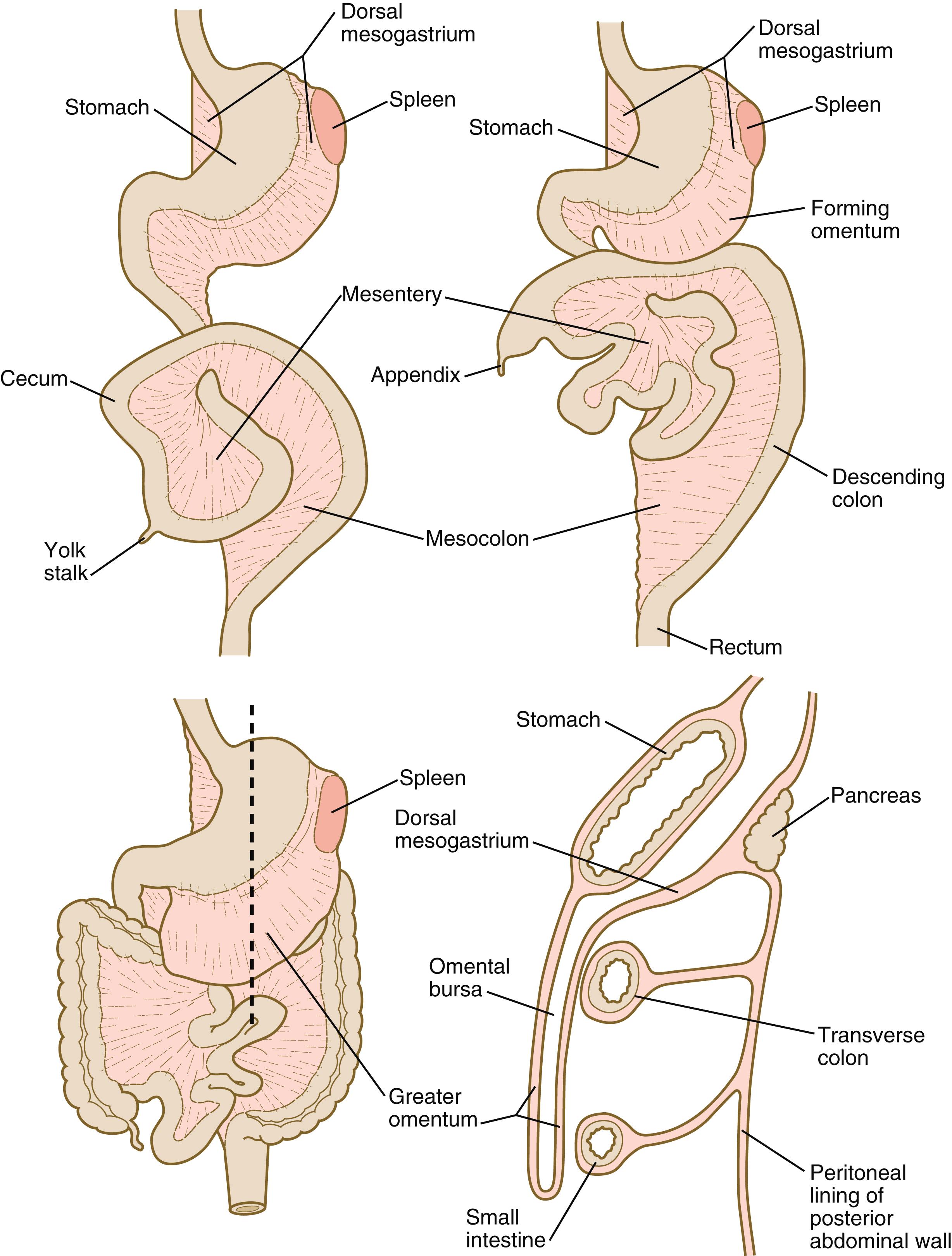
At the histological level, the gastric mucosa begins to take shape late in the second month with the appearance of folds ( rugae ) and the first gastric glands . The gastric glands increase in size and then undergo fission as a way of increasing their numbers. During the early fetal period, the individual cell types that characterize the gastric mucosa begin to differentiate. Progenitor cells produce five main types of differentiated cells—mucous cells, chief cells, parietal cells, endocrine cells, and tuft cells. The endocrine cells then produce five differentiated subtypes. The actions of different sets of transcription factors underlie the formation of each of these cell types. In addition, a resident population of stem cells near the isthmus of the gastric glands enables the turnover of gastric epithelial cells throughout life. Biochemical and cytochemical studies have shown the gradual functional differentiation of specific cell types during the late fetal period. In most mammals, including humans, cells of the gastric mucosa begin to secrete hydrochloric acid shortly before birth. As is true elsewhere in the gut, shh signaling from the endoderm is very important for the development of the smooth muscle layers of the stomach.
The caudal end of the stomach is physiologically separated from the small intestine by the muscular pyloric sphincter . The sharp morphological distinction between stomach and intestine is mirrored by an equally sharp molecular border, with the transcription factors Sox-2 defining the gastric side and Cdx-2, the intestinal domain. Formation of the pyloric sphincter is directed by the transcription factors Sox-9 and Nkx 2.5 , the expression of which in the area of pyloric mesoderm is stimulated by BMP-4 signals. Several Hox genes are needed to specify each of the three major sphincters (pyloric, ileocecal, and anal) in the digestive tract.
Clinical Correlation 15.1 presents malformations of the esophagus and stomach.
Development of the spleen is not well understood. Initially, two bilaterally symmetrical organ fields are reduced by regression to one on the left. The spleen is first recognizable as a mesenchymal condensation in the dorsal mesogastrium at 4 weeks and is initially closely associated with the developing dorsal pancreas. Initiation of splenic development requires the cooperative action of a basic helix-loop-helix protein ( Pod-1 ) and a homeobox-containing protein ( Bapx-1 ), acting through another transcription factor, Pbx-1 . Such a combination is emerging as a common theme in the initiation of development of several organs. These substances act on the downstream molecules Nkx 2.5 and the oncogene Hox-11 (T-cell leukemia homeobox-1) in early splenic development ( Figure 15.9 ).
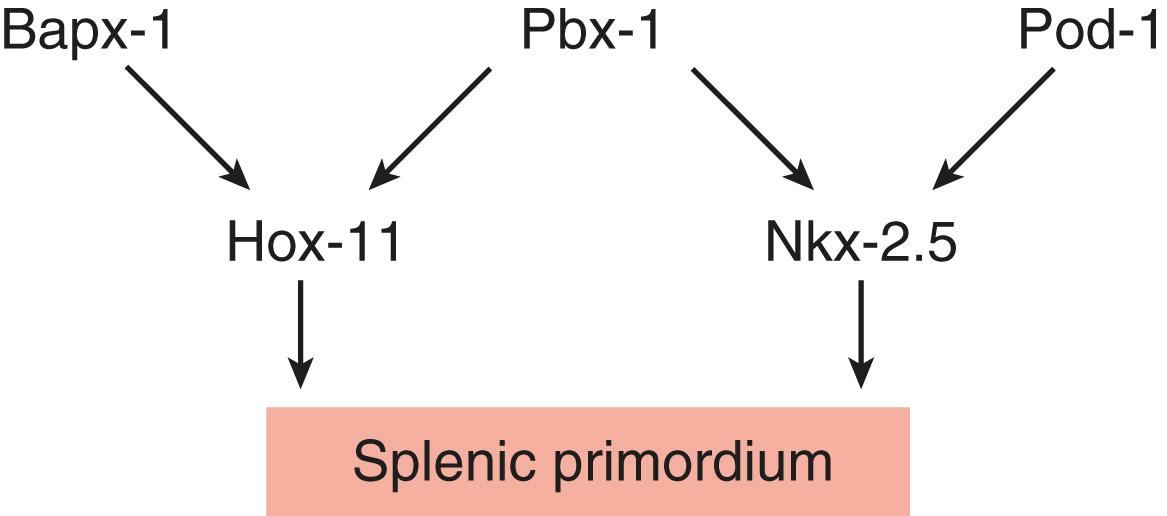
The splenic primordium consists of a condensation of mesenchyme covered by the overlying mesothelium of the dorsal mesogastrium, both of which contribute to the stroma of the spleen. Its normal left-sided location is determined early by the mechanisms that dictate heart asymmetry. Hematopoietic cells move into the spleen in the late embryonic period, and from the third to fifth months, the spleen and the liver serve as major sites of hematopoiesis during the first trimester of pregnancy. Later, the splenic primordium is infiltrated by lymphoid cells, and by the fourth month, the complex vascular structure of the red pulp begins to take shape.
The intestines are formed from the posterior part of the foregut, the midgut, and the hindgut ( Table 15.1 ). Table 15.2 summarizes the chronology of major stages in the development of the digestive tract. Two points of reference are useful in understanding the gross transformation of the primitive gut tube from a relatively straight cylinder to the complex folded arrangement characteristic of the adult intestinal tract. The first is the yolk stalk, which extends from the floor of the midgut to the yolk sac. In the adult, the site of attachment of the yolk stalk is on the small intestine approximately 2 feet cranial to the junction between small and large intestine ( ileocecal junction ). On the dorsal side of the primitive gut, an unpaired ventral branch of the aorta, the superior mesenteric artery , and its branches feed the midgut (see Figure 15.7 ). The superior mesenteric artery itself serves as a pivot point about which later rotation of the gut occurs.
| Blood Supply | Adult Derivatives |
|---|---|
| Foregut | |
| Celiac artery (lower esophagus to duodenum) | Pharynx |
| Esophagus | |
| Stomach | |
| Upper duodenum | |
| Glands of pharyngeal pouches, respiratory tract, liver, gallbladder, pancreas | |
| Midgut | |
| Superior mesenteric artery | Lower duodenum |
| Jejunum and ileum | |
| Cecum and vermiform appendix | |
| Ascending colon | |
| Cranial half of transverse colon | |
| Hindgut | |
| Inferior mesenteric artery | Caudal half of transverse colon |
| Descending colon | |
| Rectum | |
| Superior part of anal canal | |
| Normal Time (week) | Developmental Events |
|---|---|
| 3 | Tubular gut beginning to form; early induction of major digestive glands |
| 4 | Most of gut tubular; primordia of liver, dorsal and ventral pancreas, and trachea visible; rupture of oropharyngeal membrane |
| 5 | Expansion and early rotation of stomach; intestinal loop beginning to form; cecum and bile duct evident |
| 6 | Rotation of stomach completed, prominent intestinal loop; appearance of allantois and appendix; urorectal septum beginning to subdivide cloaca into rectum and urogenital sinus |
| 7 | Herniation of intestinal loop; rapid growth of liver; fusion of dorsal and ventral pancreas; cloacal septation complete |
| 8 | Counterclockwise rotation of herniated intestinal loop; recanalization of intestine; early penetration of parasympathetic neuronal precursors from cranial neural crest into gut |
| 9 | Return of herniated gut into body cavity; differentiation of epithelial types in intestinal lining |
| 10 | Villi appearing in small intestine; differentiation of goblet cells |
| 11 | Development of circular and longitudinal smooth muscle |
| 12 | Crypt formation begins |
| 16 | Villi lining entire intestine (including colon) |
| 20 | Peyer’s patches seen in small intestine |
| 24 | Intestine capable of absorption |
By 5 weeks, rapid growth of the gut tube causes it to buckle out in a hairpin-like loop. The growth in length of the intestine is caused in large part by proliferation of the mesenchymal cells within the intestinal wall. Several signaling pathways are involved in stimulating mesenchymal proliferation, but the most important ones include Wnt5a, shh, and FGF. In their absence, the intestine remains very short. The major change that causes the intestines to assume their adult positions is a counterclockwise rotation of the caudal limb of the intestinal loop (with the yolk stalk attachment and superior mesenteric artery as reference points) around the cephalic limb from its ventral aspect. The principal driver of intestinal rotation is changes in the dorsal mesentery, especially the left side. Driven by Pitx-2, a molecule directly involved in creating left-right asymmetry in the early embryo (see Figure 5.15 ), the mesenchymal cells on the left side of the dorsal mesentery become more condensed than those on the right and at the same time the epithelium on the left side becomes columnar while that on the right becomes more flattened. These cellular changes produce a buckling of the mesentery, which then pulls along the elongating gut. The main consequence of this rotation is to bring the future colon across the small intestine so that it can readily assume its C-shaped position along the ventral abdominal wall (see Figure 15.7 ). Behind the colon, the small intestine undergoes great elongation and becomes packed in its characteristic position in the abdominal cavity.
The rotation and other positional changes of the gut occur partly because the length of the gut increases more than the length of the embryo. From almost the first stages, the volume of the expanded gut tract is greater than the body cavity can accommodate. Consequently, the developing intestines herniate into the body stalk (the umbilical cord after further development) ( Figure 15.11 ). Intestinal herniation begins by 6 or 7 weeks of embryogenesis. By 9 weeks, the abdominal cavity has enlarged sufficiently to accommodate the intestinal tract, and the herniated intestinal loops begin to move through the intestinal ring back into the abdominal cavity. Coils of small intestine return first. While they do, they force the distal part of the colon, which was never herniated, to the left side of the peritoneal cavity, thus establishing the definitive position of the descending colon. After the small intestine has assumed its intra-abdominal position, the herniated proximal part of the colon also returns, with its cecal end swinging to the right and downward (see Figure 15.7 ).
The most common anomalies of the esophagus are associated with abnormalities of the developing respiratory tract (see p. 373). Other rare anomalies are stenosis and atresia of the esophagus. Stenosis is usually attributed to abnormal recanalization of the esophagus after epithelial occlusion of its lumen. Experimental evidence suggests that abnormal separation of the early notochord from the dorsal foregut endoderm is often associated with esophageal atresia, possibly through the incorporation of some of the dorsal foregut cells into an abnormal notochord. Atresia of the esophagus is most commonly associated with abnormal development of the respiratory tract. In both these conditions, impaired swallowing by the fetus can lead to an excessive accumulation of amniotic fluid (polyhydramnios). Just after birth, a newborn with these anomalies commonly has difficulty swallowing milk, and regurgitation and choking while drinking are indications for examination of the patency of the esophagus.
Pyloric stenosis, which seems to be more physiological than anatomical, consists of hypertrophy of the circular layer of smooth muscle that surrounds the pyloric (outlet) end of the stomach. The hypertrophy causes a narrowing (stenosis) of the pyloric opening and impedes the passage of food. Several hours after a meal, the infant violently vomits (projectile vomiting) the contents of the meal. The enlarged pyloric end of the stomach can often be palpated on physical examination. Although pyloric stenosis is commonly treated by a simple surgical incision through the layer of circular smooth muscle of the pylorus, the hypertrophy sometimes diminishes without treatment by several weeks after birth. The pathogenesis of this defect remains unknown, but it seems to have a genetic basis. Pyloric stenosis is more common in male than in female infants, and the reported incidence ranges from 1 in 200 to 1 in 1000 infants.
Heterotopic gastric mucosa has been found in a variety of otherwise normal organs ( Figure 15.10 ). This condition is often clinically significant because if the heterotopic mucosa secretes hydrochloric acid, ulcers can form in unexpected locations. Many cases of heterotopic tissue within the gastrointestinal tract are now thought to be caused by the inappropriate expression of genes that are characteristic of other regions of the gut, but the question remains: What is the basis of the inappropriate gene expression, and why does it often occur within a very restricted area? Given the recognition of increasingly complex networks of genetic control in the gut, it is not difficult to imagine that on occasion normal developmental controls go awry but understanding the genetic basis of specific instances of ectopic mucosa still remains elusive.
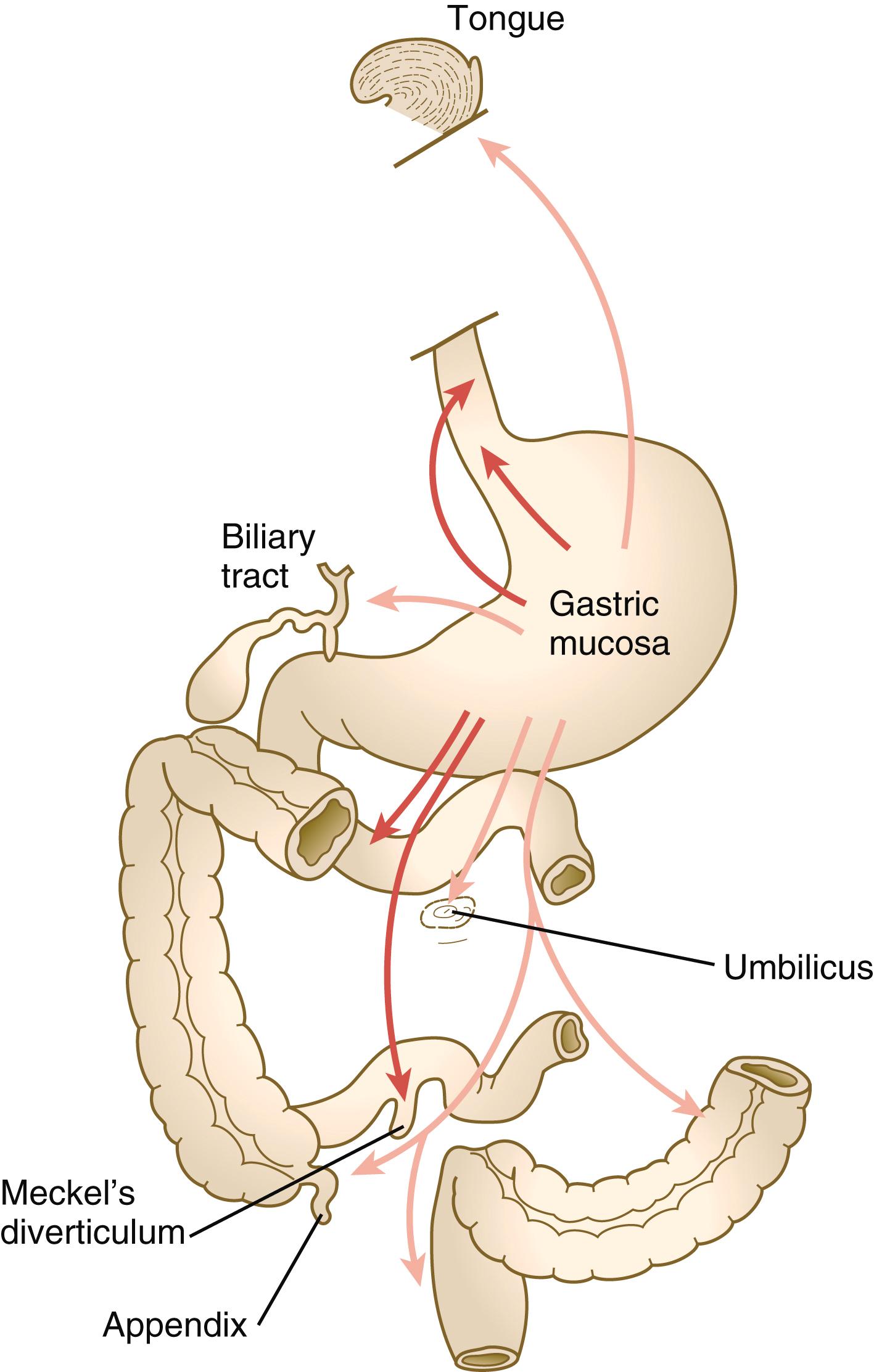
Most splenic anomalies are of the gross anatomical variety, and most are rare. They range from absence of the spleen (asplenia) to multiple (up to sixteen) smaller spleens (polysplenia). Disruption of the fusion of multiple sites of origin may account for both polysplenia and lobulation of the spleen.
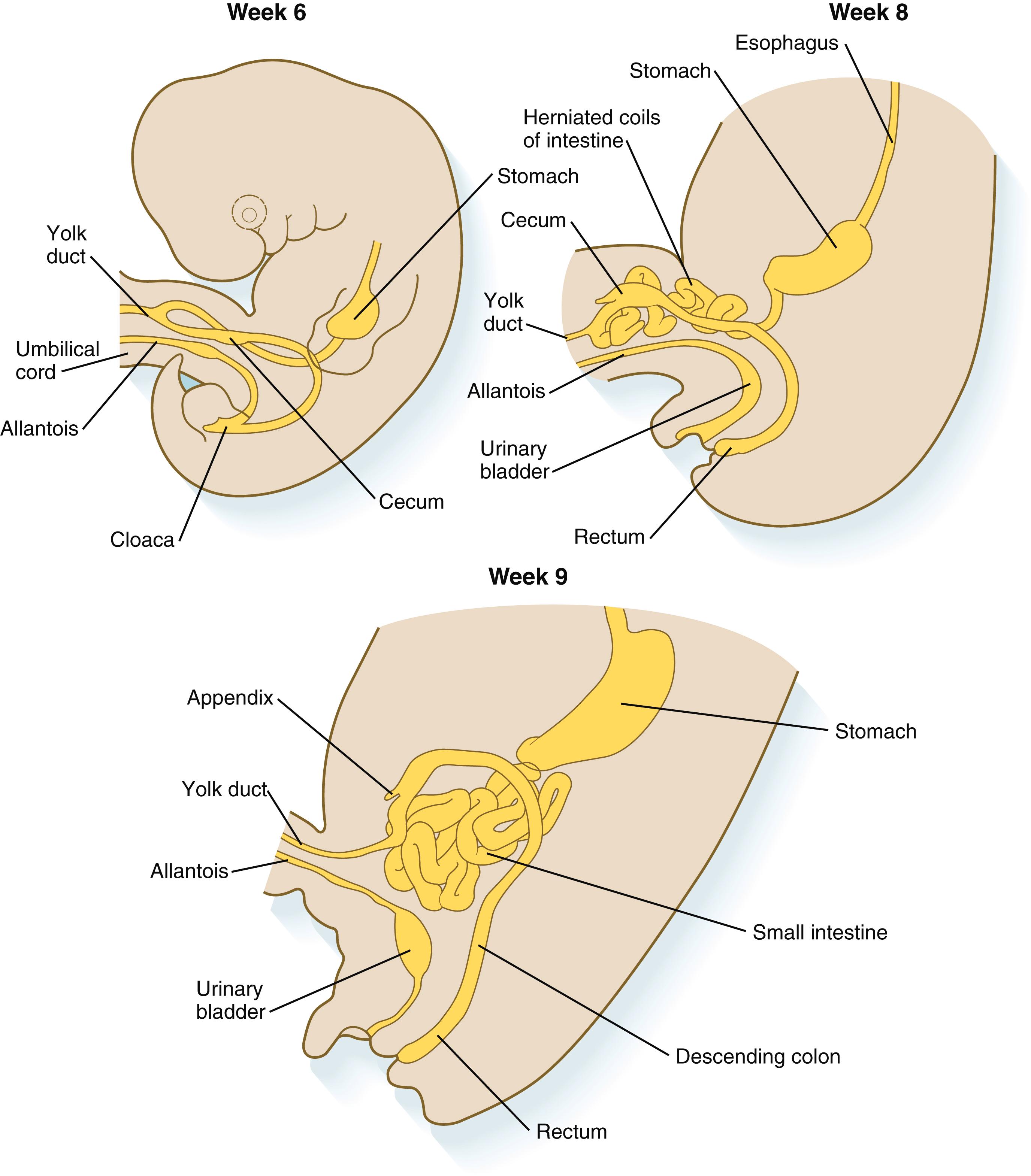
During these coilings, herniations, and return movements, the intestines are suspended from the dorsal body wall by a mesentery ( Figure 15.12 ). Looping of the intestine is caused principally by tension–compression relationships between the intestine and its dorsal mesentery. When the intestine is separated from the mesentery, the normal looping does not occur. Parts of the mesentery associated with the duodenum and colon ( mesoduodenum and mesocolon ) fuse with the peritoneal lining of the dorsal body wall.

The main regions of the small intestine depend upon the expression of several transcription factors. The domain influenced by Pdx-1 contains the upper duodenum, whereas Gata-4 is expressed in the lower duodenum and jejunum. Gata-6 is expressed in the ileum.
Starting in the sixth week, the primordium of the cecum becomes apparent as a swelling in the caudal limb of the midgut (see Figure 15.7 ). In succeeding weeks, the cecal enlargement becomes so prominent that the distal small intestine enters the colon at a right angle. The sphincter-like boundary at the cecum between the small and large intestines, similar to that in other regions of the gut, is regulated by a high concentration of Cdx-2 and a sequence of Hox gene expression. In mice, deletion of Hoxd4, Hoxd8 to Hoxd11, and Hoxd13 results in the absence of this region. When the overall pattern has been set by combinations of Hox genes, continued cecal development depends on an interaction between FGF-9 produced by the cecal epithelium and FGF-10 produced by the overlying mesoderm.
The tip of the cecum elongates, but its diameter does not increase in proportion to the rest of the cecum. This wormlike appendage is aptly called the vermiform appendix .
In the early embryo, the caudal end of the hindgut terminates in the endodermally lined cloaca , which, in lower vertebrates, serves as a common termination for the digestive and urogenital systems. The cloaca also includes the base of the allantois, which later expands as a common urogenital sinus (see Chapter 16 ). A cloacal (proctodeal) membrane consisting of apposed layers of ectoderm and endoderm acts as a barrier between the cloaca and an ectodermal depression known as the proctodeum ( Figure 15.13 ). A shelf of mesodermal tissue called the urorectal septum is situated between the hindgut and the base of the allantois. During weeks 6 and 7, the urorectal septum advances toward the cloacal membrane. At the same time, lateral mesodermal ridges extend into the cloaca.
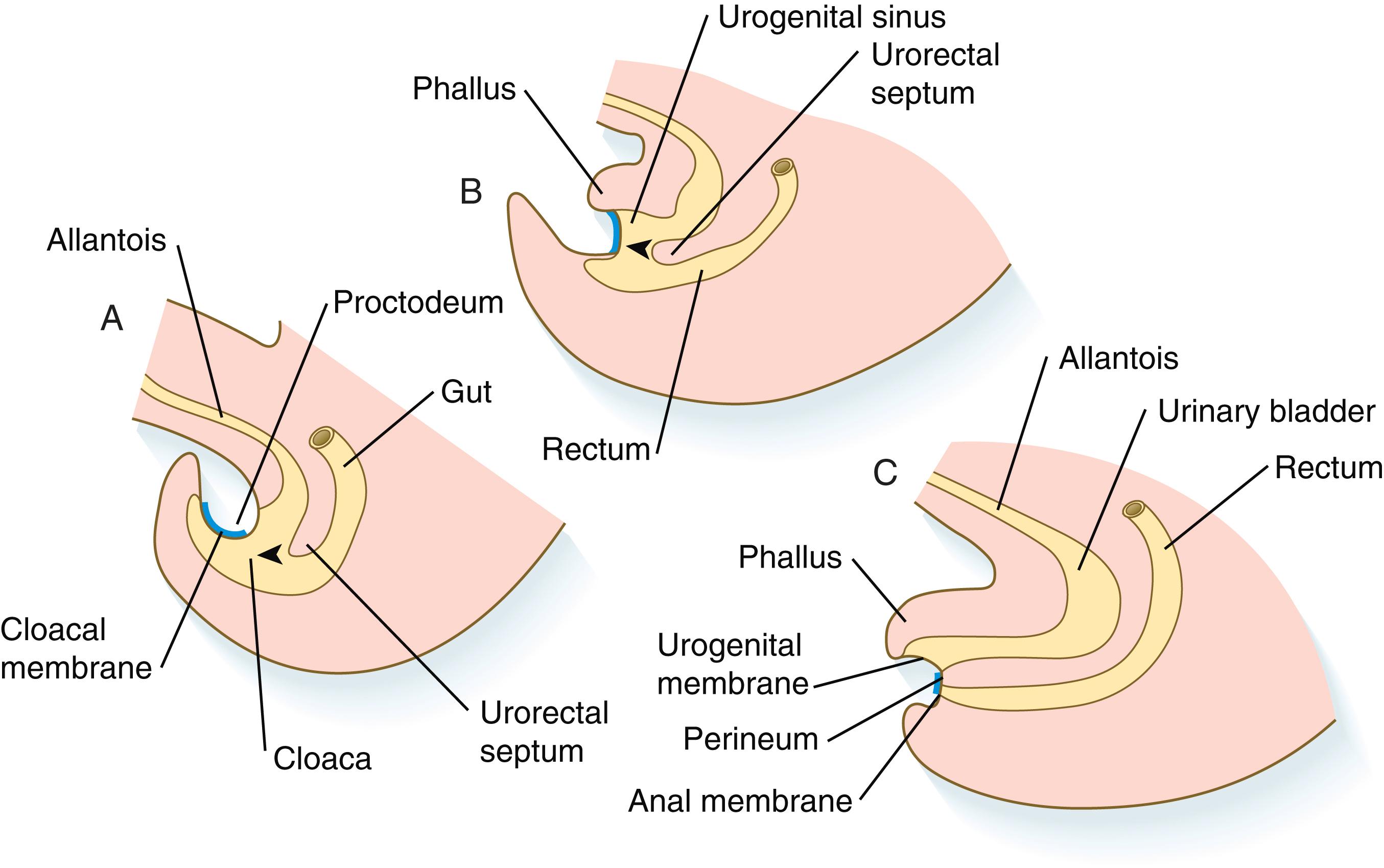
The combined ingrowth of the lateral ridges and growth of the urorectal septum toward the cloacal membrane divide the cloaca into the rectum and urogenital sinus (see Figure 15.13B ). Double mutants of Hoxa13 and Hoxd13 result in the absence of cloacal partitioning, along with hypodevelopment of the phallus (genital tubercle). In addition, they lead to the absence of the smooth muscle component of the anal sphincter. According to classic embryology, the urorectal septum fuses with the cloacal membrane, thus dividing it into an anal membrane and a urogenital membrane before these membranes break down (see Figure 15.13C ). Other research suggests that the cloacal membrane undergoes apoptosis and breaks down without its fusion with the urorectal septum. The area where the urorectal septum and lateral mesodermal ridges fuse with the cloacal membrane becomes the perineal body , which represents the partition between the digestive and urogenital systems.
The actual anal canal consists of a craniocaudal transition from columnar colonic (rectal) epithelium to a transitional region of cloacally derived endodermal epithelium leading into a zone of squamous epithelium that merges with the external perianal skin. These zones are surrounded by the smooth muscle internal anal sphincter.
Shortly after its initial formation, the intestinal tract consists of a simple layer of columnar endodermal epithelium surrounded by a layer of splanchnopleural mesoderm. Three major phases are involved in the histogenesis of the intestinal epithelium: (1) an early phase of epithelial proliferation and morphogenesis, (2) an intermediate period of cellular differentiation in which the distinctive cell types characteristic of the intestinal epithelium appear, and (3) a final phase of biochemical and functional maturation of the different types of epithelial cells. The mesenchymal wall of the intestine also differentiates into several layers of highly innervated smooth muscle and connective tissue. An overall craniocaudal gradient of differentiation is present within the developing intestine.
Epithelium. The intestinal epithelium consists of a large variety of secretory and absorptive cell types, and the kinds and numbers of these cells varies from region to region in accordance with physiological needs. As seen above, regionalization of the small intestine is strongly influenced by Pdx-1, Gata-4, and Gata-6. Another transcription factor, Atoh-1 , is a master lineage determinant of the intestinal epithelium. In its absence, no differentiated epithelial cell types form.
The patterning signals in the gut endoderm are transmitted to the underlying mesoderm, which in turn sends region-specific inductive signals back to the endoderm. These signals guide the differentiation of specific cell types. Some regional markers, such as Pdx-1, positively influence the differentiation and distribution of specific cell types, e.g., duodenal enterocytes in this case, whereas others act to inhibit the spread of other regional cell types. Examples of the latter are Gata-6 . If Gata-6 activity is suppressed, colonic markers are expressed in the ileum, suggesting that Gata-6 may act as a colonic suppressor in the ileum. Similarly, Gata-4 suppresses ileal identity in the jejunum.
The early intestinal epithelium is pseudostratified. Late in the second month, proliferation of the epithelial cells causes the lumen to be almost plugged with epithelial cells. The intestine then recanalizes and villi begin to form. During this period, the differentiation of specific types of epithelial cells begins to occur.
Smooth Muscle. The smooth muscle layers in the intestinal wall arise in a sequential order, with the circular muscle appearing first. This is followed by formation of the outer longitudinal layer and finally, the thin muscularis mucosae. Intestinal smooth muscle formation is stimulated by hedgehog (shh or Ihh) molecules, which activate myocardin , the master regulator of smooth muscle formation. At the same time, BMP, which ironically is stimulated by hedgehog, acts to inhibit smooth muscle formation ( Figure 15.14 ).

The stimulatory gradient of hedgehog outlasts the inhibitory gradient of BMP, and at a certain point, the concentration of hedgehog is sufficiently high to induce the formation of the circular smooth muscle. At this point, formation of the outer longitudinal smooth muscle is inhibited by an opposing gradient of BMP arising from the outermost mesenchyme. Next, Auerbach’s plexuses of the enteric nervous system become established. These cells secrete BMP inhibitors, with the result that the hedgehog levels on the outside of the circular muscle layer are now enough to stimulate the differentiation of a new population of smooth muscle cells outside the circular layer. These new cells are the basis for the formation of the longitudinal layer of smooth muscle. One explanation for the longitudinal orientation of the cells of the outer layer of smooth muscle involves mechanical forces generated by the periodic contractions of the cells of the inner circular layer and the alignment of the developing smooth muscle cells along lines of tension.
Close to the endodermal lining of the gut, another set of enteric nervous system ganglia (Meissner’s plexus) takes shape and secretes BMP inhibitors. Due to their action, the concentration of uninhibited hedgehog just beneath the endothelial layer surrounding the lumen is now sufficient to stimulate the formation of a new smooth muscle layer, the muscularis mucosae.
Villus Formation. One of the most important aspects of intestinal development is the development of an absorptive surface large enough to accommodate the digestive needs of the individual. In the adult, this surface is estimated to be approximately 30 m 2 . Several mechanisms are involved in the process of converting an essentially smooth bore tube to one replete with folds and projections, namely villi and microvilli .
Research on chick embryos has shown that the larger dimensions of mucosal irregularities form in relation to the sequence of smooth muscle development within the intestinal wall. The first layer of smooth muscle to form is the circular layer. While the muscle fibers within this layer begin to contract, they force the intestinal mucosa into a parallel series of longitudinal folds. Next to differentiate is the longitudinal muscle layer. Contractions of the longitudinal muscles lead to the formation of transverse folds, called plicae . The third layer to form is the muscularis mucosae, and it may play a role in the formation of intestinal villi. It appears that in mammals, physical forces produced by smooth muscle play a lesser role in shaping villus formation in the small intestine than is the case in birds.
Early in the second month, the epithelium of the small intestine begins a phase of rapid proliferation that causes the epithelium temporarily to occlude the lumen by 6 to 7 weeks’ gestation. Within a couple of weeks, recanalization of the intestinal lumen has occurred, but the lining of the gut is smooth.
Prior to villus formation, the gut is lined by a highly proliferative pseudostratified epithelium. Villus formation is initiated by the secretion of shh and Indian hedgehog by the endodermal cells. This causes localized clusters of mesenchymal cells to form beneath the endoderm.The patterning of these clusters appears to be based on a self-organizing principle first proposed by Alan Turing, the father of modern computer science. This sequence of pattern formation begins in the anterior intestine and proceeds posteriorly. Signals from these clusters cause the conversion of the overlying pseudostratified epithelium of the gut lining to a more readily deformable simple columnar variety. Thinning of the epithelial cells and growth of the underlying mesenchymal clusters results in local buckling of the epithelium over the clusters. Buckling increases the concentration of endodermal hedgehog in the underlying mesenchyme. This stimulates the production of BMP by the mesenchymal cells. In addition to regulating the size of the clusters, BMP also inhibits proliferation of the overlying endodermal cells at the tips of the nascent villi. Continued outgrowth of the villi is accomplished through increasing the mass of the clusters, epithelial cell division along the sides, and broadening of the epithelial cells at the tips.
The intestine grows in length by enlargement of the intervillous spaces through cell proliferation, and new villi begin to emerge in these spaces. While the villi elongate, the epithelial cells covering them further increase the total absorptive area by forming numerous microvilli on their apical surfaces.
Starting at the end of the third month, pitlike intestinal crypts form at the bases of the villi. Crypt formation begins by the expression of CD44v6 , a cell surface glycoprotein, by a small group of intervillus epithelial cells. Within these cells, localized myosin expression constricts the apex, collectively causing a depression in the intervillus epithelium. These cells then invaginate into the underlying mesenchyme, causing the formation of the pitlike crypts.
Toward the bottom of the crypts are epithelial intestinal stem cells , which, in response to Wnt signaling, have a high rate of mitosis and serve as the source of epithelial cells for the entire intestinal surface ( Figure 15.15 ). Despite the presence of four to six stem cells per crypt, it has been shown that each crypt is monoclonal (i.e., all the existing cells are descendants of a single stem cell from earlier in development). Toward the top of a crypt, shh and Ihh signaling stimulate the activity of BMP . This BMP has two main functions. It counteracts the effects of Wnt and thus keeps proliferation deep in the crypt, and it also facilitates cellular differentiation. Aided in part by an ephrin-eph gradient, progeny of the stem cells make their way up the wall of the crypt as multipotential transit amplifying cells that, under the influence of the Delta-Notch system, begin to differentiate into the four main mature cell types of the intestinal epithelium (see Figure 15.15 ). These cells both differentiate and migrate toward the tip of the villus, until after approximately 4 days they die and are shed into the intestinal lumen while they are replaced below by new epithelial cells derived from the crypts. Human intestinal epithelial cells develop the intrinsic capacity for apoptosis by 18 to 20 weeks of gestation.
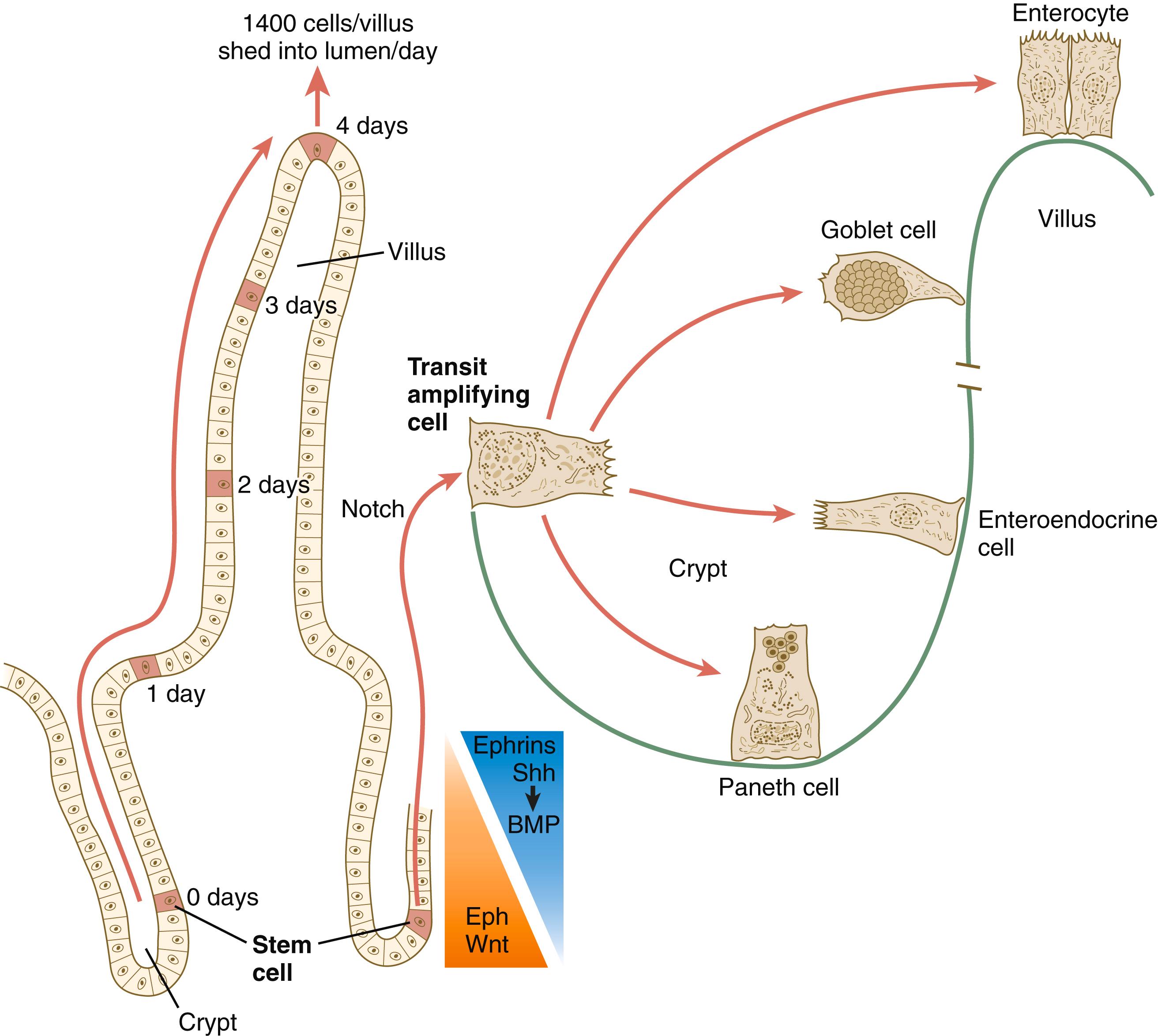
By the end of the second trimester of pregnancy, all cell types found in the adult intestinal lining have differentiated, but many of these cells do not possess adult functional patterns. Several specific biochemical patterns of differentiation are present by 12 weeks’ gestation and mature during the fetal period. For example, lactase , an enzyme that breaks down the disaccharide lactose (milk sugar), is one of the digestive enzymes synthesized in the fetal period in anticipation of the early postnatal period during which the newborn subsists principally on the mother’s milk. Further biochemical differentiation of the intestine occurs after birth, often in response to specific dietary patterns.
Histodifferentiation of the intestinal tract is not an isolated property of the individual tissue components of the intestinal wall. During the early embryonic period and sometimes into postnatal life, the epithelial and mesodermal components of the intestinal wall communicate by inductive interactions. In region-specific manners, these interactions involve hedgehog signaling ( shh for the foregut and midgut and Ihh for the hindgut) from the endodermal epithelium. BMP signaling from the mesoderm is involved in positioning the crypts and villi in the small intestine and the glands of the colon.
Final enzymatic differentiation of intestinal absorptive cells is strongly influenced by glucocorticoids, and the underlying mesoderm seems to mediate this hormonal effect. Although the intestine develops many functional capabilities during the fetal period, no major digestive function occurs until feeding begins after birth. The intestines of the fetus contain a greenish material called meconium (see Figure 18.9 ), which is a mixture of lanugo hairs and vernix caseosa sloughed from the skin, desquamated cells from the gut, bile secretion, and other materials swallowed with the amniotic fluid.
As outlined in Chapter 12 , the enteric ganglia of the gut are derived from neural crest. Pax-3–expressing cells from the vagal neural crest migrate into the foregut and spread in a wavelike fashion throughout the entire length of the gut during weeks 4 to 7. Slightly later, cells from the sacral crest enter the hindgut and intermingle with cells derived from the vagal neural crest. A small subset of Schwann cell precursors also enters the gut and contributes to the enteric nervous system. The migratory properties of vagal crest cells are much more pronounced than are those of cells from the sacral crest. Initially, the vagal crest cells migrate throughout the mesenchyme of the gut, but as the smooth muscle of the intestines begins to differentiate, the migrating vagal crest cells become preferentially distributed between the circular and longitudinal layers of smooth muscle, where the myenteric plexuses form. They are absent from the connective tissue of the submucosa because of the inhibiting effects of shh , secreted by the epithelial cells. After formation of the myenteric plexuses, netrin-1, secreted by the endothelium, stimulates certain enteric precursor cells to undertake a radial migration from the myenteric plexuses toward the mucosa, where they colonize the submucosa to form the submucosal plexuses.
As they migrate through the gut, the population of neural crest cells undergoes a massive expansion until the number of enteric neurons ultimately exceeds the number of neurons present in the spinal cord. Glial cells also differentiate from neural crest precursors in the gut, but the environmental factors that contribute to the differentiation of neural crest cells in the gut wall remain poorly understood.
Clinical Correlation 15.2 presents malformations of the intestinal tract.
Duodenal stenosis and atresia typically result from absent or incomplete recanalization of the duodenal lumen after it is plugged by endothelium or from vascular obstruction during pregnancy. These malformations are rare.
A rare anomaly is a very shortened small intestine, which is the major pathological finding in the congenital short bowel syndrome . The length of the intestine is typically ∼20% of normal at birth. The fundamental pathology is lack of elongation of the embryonic gut. Although little is yet known about its pathogenesis, mutations in two genes ( CLMP , encoding for a protein involved in tight junctions, and FLNA , encoding for filamin a) are associated with most of the human cases. The relationship between these genes and intestinal elongation is presently under investigation.
A common family of anomalies of the intestinal tract is some form of persistence of the vitelline (yolk) duct . Most prominent is Meckel’s diverticulum , which is present in 2% to 4% of the population. Typical Meckel’s diverticulum is a blind pouch a few centimeters long located on the antimesenteric border of the ileum about 50 cm cranial from the ileocecal junction ( Figure 15.16A and E ). This structure represents the persistent proximal portion of the yolk stalk. Simple Meckel’s diverticula are often asymptomatic, but they occasionally become inflamed or contain ectopic tissue (e.g., gastric, pancreatic, or even endometrial tissue), which can cause ulceration. Ulceration of a Meckel’s diverticulum can cause bleeding, especially in young children. Therefore this condition should be included in the differential diagnosis when gastrointestinal bleeding is discovered in a young child.
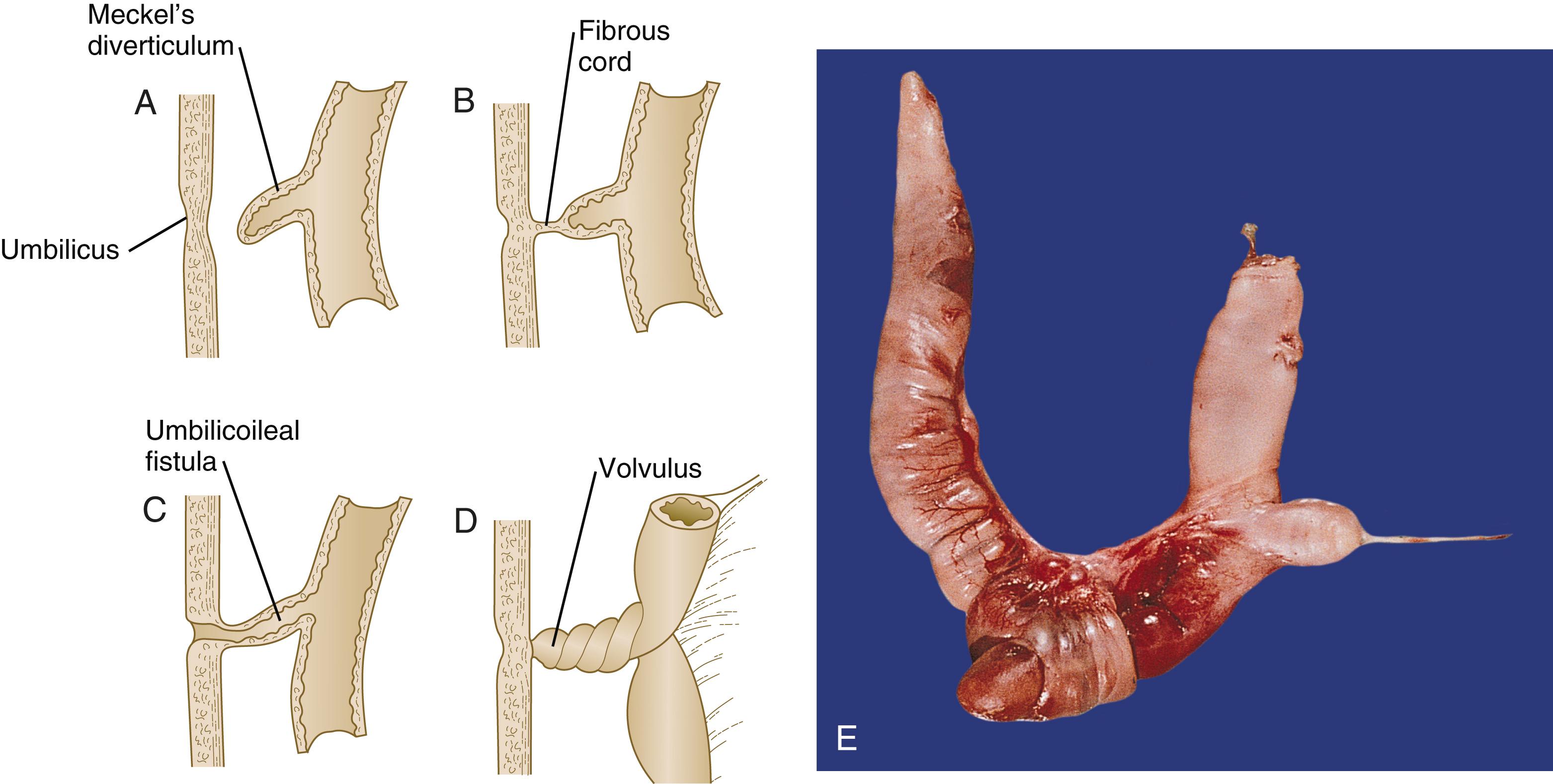
In some cases, a simple ligament (see Figure 15.16B ) or a ligament containing a persisting vitelline artery can connect the intestine to the umbilicus. Occasionally, the intestine rotates about such a ligament and causes a condition known as volvulus (see Figure 15.16D ). This disorder can lead to strangulation of the bowel.
A persistent vitelline duct can take the form of a vitelline fistula (see Figure 15.15C ), which constitutes a direct connection between the intestinal lumen and the outside of the body via the umbilicus. Rarely, a vitelline duct cyst is present along the length of a vitelline ligament.
Become a Clinical Tree membership for Full access and enjoy Unlimited articles
If you are a member. Log in here